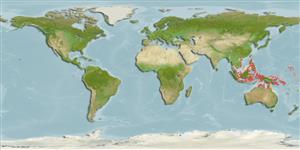>
Ovalentaria/misc (Various families in series Ovalentaria) >
Pomacentridae (Damselfishes) > Pomacentrinae
Etymology: Dischistodus: Greek, di = two + Greek, schistos = fissile stone, Plinius + Greek, odous = teeth (Ref. 45335).
More on author: Cuvier.
Environment: milieu / climate zone / depth range / distribution range
Ecologia
marinhas associadas(os) a recifes; não migratória; intervalo de profundidade 1 - 8 m (Ref. 7247). Tropical; 21°N - 20°S
Western Pacific: Indonesia, Philippines and northern Australia.
Tamanho / Peso / Idade
Maturity: Lm ? range ? - ? cm
Max length : 11.5 cm SL macho/indeterminado; (Ref. 7247)
Espinhos dorsais (total): 13; Raios dorsais (total): 13-14; Espinhos anais 2; Raios anais : 13 - 14.
Adults inhabit silty lagoon and coastal reefs around coral outcrops and seagrass beds (Ref. 9710). Often adjacent to clear mangrove coasts among rubble and Sargassum algae, to a few meters depth (Ref. 48636). Oviparous, distinct pairing during breeding (Ref. 205). Eggs are demersal and adhere to the substrate (Ref. 205). Males guard and aerate the eggs (Ref. 205). Diurnal species (Ref. 52881).
Ciclo de vida ou comportamento de acasalamento
Maturidade | Reprodução | Desova | Ovos | Fecundidade | Larvas
Oviparous, distinct pairing during breeding (Ref. 205). Eggs are demersal and adhere to the substrate (Ref. 205). Males guard and aerate the eggs (Ref. 205).
Allen, G.R., 1991. Damselfishes of the world. Mergus Publishers, Melle, Germany. 271 p. (Ref. 7247)
Status na Lista Vermelha da UICN (Ref. 130435)
Warning: mysqli::__construct(): (HY000/1040): Too many connections in /var/www/html/includes/func_getlabel.php on line 46
Can't connect to MySQL database (fbapp). Errorcode: Too many connections
